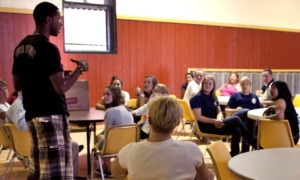Video by Roger Newton
Listen to the interview of reporter Tammy Joyner and Georgia State University Sociology Chair Eric Wright on GPB Atlanta 88.5 FM in the program “On Second Thought.”
ATLANTA — Medical sociologist Eric Wright’s work has taken him into parks, abandoned buildings, shelters and other places off the beaten path.
It has given the Georgia State University professor a raw glimpse of some of America’s toughest social issues: mental illness, drug and alcohol abuse as well as sexually transmitted diseases such as HIV. Wright’s research has led to another discovery.
“I found myself running into more homeless teens,” he said.
Wright has talked to hundreds of homeless youth over the past five years. The encounters have given him a unique perspective on a large swath of forgotten and abandoned kids as they navigate the streets and social services daily while trying to stay out of the juvenile justice system.
Their constantly on-the-move lifestyle makes it hard to gauge the exact number of young people experiencing homelessness, especially in big cities. Wright, however, has managed to capture Atlanta’s numbers. He helped develop a data-collection system that gives metro Atlanta leaders a more accurate count of youth homelessness. (In 2015, the last GSU point-in-time count done, there were about 3,373 homeless youth in metro Atlanta, he said.)
The Southeast has become a magnet for many young people, Wright said. They come to Atlanta, for example, looking to break into music or film. Sunny climes and trendy, youth-oriented culture lure them to the region. Atlanta also draws its share of young gay people who view it as a liberal, progressive Southern city.
“Atlanta is pretty well known as the gay mecca of the South,” Wright said.
But their dreams often collide with reality. Jobs don’t pan out. Decent, affordable housing is hard to find. When that happens, some can’t or won’t go home and they wind up on the street, he said.
Wright sat down with reporter Tammy Joyner to talk about what young homeless people are experiencing.
Homeless teens and justice system
Q: What does youth homelessness look like in America?
A: There are two groups of homeless youth. Homeless youth who are attached to families and homeless youth living on their own.
Homeless families may go to a facility to get support but then there are rules and regulations that prohibit some of the children from coming into those facilities. A lot of places will not take teenage boys. So young men who are attached to their families are sometimes put out on the street by their own families. The parents are put in this untenable situation where they have to choose between their kids. There’s a general misguided perception among the public, policymakers and some service providers that all teenage boys are sexual predators. So they don’t want to put them in family facilities.
Most of them start crossing that line around 12, 13, 14. The assumption is that a pubescent male becomes a sexual predator. That’s an unfortunate assumption because I don’t think that’s accurate, at least certainly not given the data. I’ve even heard of fathers who will go out and sleep in the car with their son because sometimes the facilities won’t even take in the adult male.
Q: Is there a correlation between homeless teens and the juvenile justice system?
A: A large number have had some contact with the police, but that doesn’t necessarily translate into a charge or jail time. We did find some youth spent time in jail. The most heartbreaking statistic, which speaks to juvenile justice in a different way, was that 51 percent of the [homeless] youth reported watching their parent or guardian go off to jail. That’s a huge proportion. If you think about that as a social problem, we talk a lot about the controlling of crime and locking bad people up, but we never think about the results of that on the family. Jailing people can increase the economic marginality of the family members and that’s compounded further on youth.
Q: Some officials at programs that work with homeless teens say it’s hard to quantify an intervention program’s success rate in keeping homeless teens out of the juvenile justice system. Is there a way to quantify their success?
A: Technically yes. If I were doing it, you’d follow a young person for a longer period of time. Most agencies get federal or state dollars. Most evaluations only follow a young person for six months to a year. You need to follow them longer. You want to follow them until they become a stable adult. To the best of my knowledge, no one’s ever done that type of longitudinal study. It would be very hard to do and very costly because these kids are mobile.
Homelessness has morphed
Q: How are homeless youth different from older or the more chronically homeless?
A: They tend to be a lot more mobile, physically and internet-wise. They look for jobs and other youth to hang out with. Most have cellphones. They hang out at Starbucks, Caribou Coffee or other places where they can get free Wi-Fi. They use libraries more. They’re much more wired and mobile than adult homeless.
Q: Was there a turning point that led to the growth in youth homelessness?
A: I think 2008 was a good marking point. The homeless population has shifted since the last decade. The recession and housing crisis generated a lot of economic insecurity. The concentration of wealth has created a complicated, insidious problem around housing instability and affordability.
The face of homelessness has changed. In previous decades, it was largely single male adults. It’s now shifting from a single person to families, and possibly from the North to the South. Complicating matters is the growing number of people moving to the South, especially African Americans seeking more affordable housing and economic opportunities. This may be contributing to a larger proportion of African Americans among the homeless populations in Atlanta and other Southern cities. The 2008 recession hit minorities particularly hard. They have not benefited from the recovery as much as white Americans.
Q: What do homeless youth say is their biggest problem?
A: Trying to find places to house youth. Younger people tend to have more problems when they go to traditional homeless shelters. They often become targets of the older homeless. They might get exploited and beat up. Drug dealers will often prey on them.
There’s a pecking order of exploitation going on within the homeless population and that’s compounded when you put them all in one facility. Kids 14 to 25 talk about being sexually assaulted, especially if they’re transgender. They’re the most vulnerable. I don’t think our study [the 2015 Atlanta Youth Count and Needs Assessment of about 1,100 youth 14 to 25] [would be] any different if you did the study in Durham [N.C.] or New York City.
The most important thing to keep in mind is once we’ve identified them, what services do we provide to them? We need to make services more youth-centered and identify more effective strategies to encourage them to accept services.
Q: What keeps young people homeless?
A: Probably the structure of our government and the lack of available resources. There are many government and policy silos such as the housing authority and mental health facilities. Currently, housing people think just in terms of housing. Service people think solely about case management and mental health people think about treatment. We’ve got to get them talking to each other. It’s about [creating] a more coordinated response and making sure the resources are there.
Editor’s note: This article, part of a series on homelessness and its intersection with youth justice, is made possible in part by support from the Park, Raikes and Tow foundations. Throughout this project, Youth Today will maintain editorial independence.





























